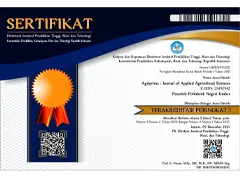Evaluation of the Insecticidal Activity of Essential Oil Extracted by SteamDistillation from Fresh Leaves of Melaleuca leucadendronon Sitophiluszeamais, a Pest of Maize Stocks
DOI:
10.25047/agriprima.v9i2.779Downloads
Abstract
Post-harvest losses due to insect pests represent a major challenge for cereal conservation in sub-Saharan Africa, particularly for maize storage. Conventional chemical insecticides, although effective, present risks of toxicity, environmental pollution, and the development of insect resistance. As a result, research has increasingly focused on natural, sustainable alternatives derived from aromatic plants. This study evaluates the insecticidal activity of essential oil extracted by steam distillation from fresh Melaleuca leucadendron leaves against Sitophilus zeamais, the main pest affecting maize stocks in Senegal. The extractions yielded an average of 0.75%, and GC-MS analysis revealed a composition dominated by sesquiterpenes, mainly γ-gurjunene (35.47%), nerolidol (17.47%), and farnesol (15.51%), indicating a high content of bioactive compounds. Maize grains were treated with different doses of oil (25 to 100 μL) and exposed to insects for 36 days, with adult mortality and the emergence of new generations being monitored and analyzed by ANOVA. The results show that mortality is highly dose-and time-dependent, with high doses causing total mortality on the first day, while lower doses induce a slower but longer-lasting residual effect. The emergence of new generations is significantly reduced, especially at high concentrations, and the efficacy is attributed mainly to sesquiterpenes, possibly enhanced by the synergistic effect of minor compounds. These observations suggest that M. leucadendron essential oil is a promising natural alternative to chemical insecticides for maize preservation, although further research is needed to optimize its formulation and stability and to assess its impact on grain quality.
Keywords:
Aktivitaas insektisida, Distilasi uap, Minyak atsiri, Melaleuca leucadendro, Sitophilus zeamaisReferences
Abdelgaleil, S. A. M., Mohamed, M. I. E., Badawy, M. E. I., & El-arami, S. A. A. (2009). Fumigant and Contact Toxicities of Monoterpenes to Sitophilus oryzae (L.) and Tribolium castaneum (Herbst) and their Inhibitory Effects on Acetylcholinesterase Activity. Journal of Chemical Ecology, 35(5), 518–525.
Adams, R. P. (2009). Identification des composants des huiles essentielles par chromatographie en phase gazeuse/spectrométrie de masse (4th ed.). Allured Publishing Corporation.
Cissokho, P., Gueye, M., Sow, E., & Diarra, K. (2015). Substances inertes et plantes à effet insecticide utilisées dans la lutte contre les insectes ravageurs des céréales et légumineuses au Sénégal et en Afrique de l’Ouest. International Journal of Biological and Chemical Sciences, 9(3), 1644.
Cohen, J. (1988). Statistical Power Analysis for the Behavioral Sciences. Lawrence Erlbaum Associates.
Diallo, A., Tine, Y., Sène, M., Diagne, M., Diop, A., Ngom, S., Ndoye, I., Boye, C. S. B., Sy, G. Y., Costa, J., Wélé, A., & Paolini, J. (2022). The essential oil of Melaleuca leucadendra L. (Myrtaceae) from Fatick (Senegal) as a source of methyleugenol. Composition, antibacterial and anti-inflammatory activities. Journal of Essential Oil Research, 34(4), 322–328.
Diop, S. M., Gueye, M. T., Ndiaye, E. H. B., Thiam, A., Cissokho, P. S., Sanghare, C. H., & Fauconnier, M.-L. (2021). Activités antioxydante et insecticide d’huiles essentielles de Mentha arvensis L. du Sénégal. International Journal of Biological and Chemical Sciences, 15(3), 966–975.
Fall, R., Ngom, S., Samb, A., & Sembène, M. (2017). Activité insecticide par fumigation des huiles essentielles de Callistemon viminalis, Melaleuca leucadendron et Hyptis suavolen contre Sitophilus spp., ravageur du maïs. Journal de La Société Ouest-Africaine de Chimie, 43, 31–36.
Gamal El-Din, M. I., Youssef, F. S., Altyar, A. E., & Ashour, M. L. (2022). GC/MS Analyses of the Essential Oils Obtained from Different Jatropha Species, Their Discrimination Using Chemometric Analysis and Assessment of Their Antibacterial and Anti-Biofilm Activities. Plants, 11(9), 1268.
Isman, M. B. (2020). Botanical Insecticides in the Twenty-First Century—Fulfilling Their Promise? Annual Review of Entomology, 65(1), 233–249.
Joshi, A., Prakash, O., Pant, A. K., Kumar, R., Szczepaniak, L., & Kucharska-Ambrożej, K. (2021). Methyl Eugenol, 1,8-Cineole and Nerolidol Rich Essential Oils with their Biological Activities from three Melaleuca Species Growing in Tarai Region of North India. Brazilian Archives of Biology and Technology, 64.
Ko, K., Juntarajumnong, W., & Chandrapatya, A. (2009). Repellency, Fumigant and Contact Toxicities of Melaleuca cajuputi Powell against Sitophilus zeamais Motschulsky and Tribolium castaneum Herbst. Thai Journal of Agricultural Science, 42(1), 27–33.
Mirbakhsh, M., & Sohrabi, S. S. (2022). Effect of short and long period of salinity stress on physiological responses and biochemical markers of Aloe vera L. Ilmu Pertanian (Agricultural Science), 7(3), 178.
Ndiaye, E. B., Gueye, M. T., Diop, S. M., Thiam, A., Sanghare, C. H., Diop, M. B., & Fauconnier, M. L. (2021). Chemical composition of essential oils and floral waters of Eucalyptus camaldulensis (Dehnh) from two locations in Senegal.
Padalia, R. C., Verma, R. S., Chauhan, A., & Chanotiya, C. S. (2015). The essential oil composition of Melaleuca leucadendra L. grown in India: A novel source of (E)-nerolidol. Industrial Crops and Products, 69, 224–227.
Rants’o, T. A., Koekemoer, L. L., & van Zyl, R. L. (2023). In vitro and in silico analysis of the Anopheles anticholinesterase activity of terpenoids. Parasitology International, 93, 102713.
Regnault-Roger, C., Vincent, C., & Arnason, J. T. (2012). Essential Oils in Insect Control: Low-Risk Products in a High-Stakes World. Annual Review of Entomology, 57(1), 405–424.
Selem, E., Hassan, A. A. S. A., Awad, M. F., Mansour, E., & Desoky, E.-S. M. (2022). Impact of Exogenously Sprayed Antioxidants on Physio-Biochemical, Agronomic, and Quality Parameters of Potato in Salt-Affected Soil. Plants, 11(2), 210.
Soulama, S., Kadeba, A., Nacoulma, B., Traore, S., Bachmann, Y., & Thiombiano, A. (2015). Impact des activités anthropiques sur la dynamique de la végétation de la réserve partielle de faune de Pama et de ses périphéries (sud-est du Burkina Faso) dans un contexte de variabilité climatique. Journal of Applied Biosciences, 87(1), 8047.
Sparkman, O. D., Penton, Z., & Kitson, F. G. (2011). Chromatographie en phase gazeuse et spectrométrie de masse: guide pratique. Presses Universitaires.
Tak, J.-H., & Isman, M. B. (2017). Penetration-enhancement underlies synergy of plant essential oil terpenoids as insecticides in the cabbage looper, Trichoplusia ni. Scientific Reports, 7(1), 42432.
Tran, P. H., Vu, T. T. T., Phan, T. D. T., Nguyen, V. M., Ngo, T. N. M., Le, C. V. C., & Ton, T. H. D. (2024). Chemical compositions and biological properties of the leaf essential oil of three Melaleuca species. World Academy of Sciences Journal, 6(6), 67.
Ziane, A., & Bouredji, M. (2024). Effet insecticide de l’huile essentielle d’Eucalyptus globulus sur un insecte d’intérêt économique Scientifique [University of Tebessa].
License
Copyright (c) 2025 El Hadji Gorgui DIOUF, Adama Faye, Ababacar Diouf, Alioune Diouf, Mamadou Latyr Ndour, Mamadou Kébé, Talibouya Ndior, Alioune Ndiaye (Author)

This work is licensed under a Creative Commons Attribution-ShareAlike 4.0 International License.
You are free to:
- Share — copy and redistribute the material in any medium or format.
- Adapt — remix, transform, and build upon the material for any purpose, even commercially.
Under the following terms:
- Attribution — You must give appropriate credit, provide a link to the license, and indicate if changes were made. You may do so in any reasonable manner, but not in any way that suggests the licensor endorses you or your use.
- ShareAlike — If you remix, transform, or build upon the material, you must distribute your contributions under the same license as the original.
- No additional restrictions — You may not apply legal terms or technological measures that legally restrict others from doing anything the license permits.









